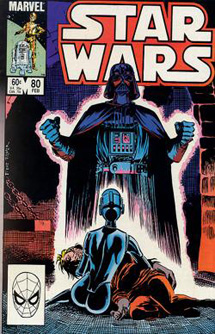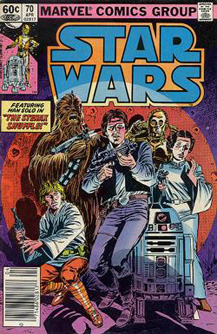I was looking forward to re-reading Mary Jo Duffy’s early issues in the Marvel run, as I vaguely recalled complex plots about the quest to rescue Han Solo and the search for missing X-wing pilot Tay Vanis, who possesses the Death Star II plans. About halfway through these 12 issues — which spring from the end of David Michelinie’s work and lead directly up to “Return of the Jedi” — the movie hit theaters, allowing Duffy to stop being vague and directly address story points.
And indeed, if a reader were to pick up Issue 80, “Ellie,” they would assume it is the culmination of our heroes’ long, involved quest to find Vanis. However, Luke, Leia and C-3PO simply start the issue on the planet where they’ll find Vanis based on some intelligence passed on to them off-page by the Alliance hierarchy. This is often the case with Duffy’s work: The Alliance positions our heroes somewhere, then the adventure ensues. While “Ellie’s” final image of C-3PO “crying” (it’s rain, of course) over the death of Vanis and Ellie remains stylish, the story itself is thin. And it’s not clear exactly why the Bothans passed the plans on to Vanis (instead of, for example, Jedi Knight Luke Skywalker), especially since Vanis is not mentioned at all in “Shadows of the Empire.”

Likewise, the “Hunt for Han” plot is thin. In issue 79, “The Big Con,” Lando and Chewie learn that Boba Fett is taking Han to Jabba’s palace, thus setting the stage for “Jedi.” The story is fun, with Lando in fine form as “Captain Drebble,” but the revelation of Han’s whereabouts is anticlimactic. At least this thread squares with “Shadows,” as Lando notes that he’s been staking out Tatooine, waiting for Fett to arrive.
Duffy’s run starts off strongly with a three-parter on Stenos (issues 70-72 — “The Stenax Shuffle,” “Return to Stenos” and “Fool’s Bounty”), especially the first issue, which includes Han in flashback. The backstabbing Rik Duel makes a fitting rival for Han, and the sexually charged Zeltrons — notably Dani, who is all over Luke — are delicious comic relief. Duffy is at her best when scripting a fun romp, and she works well with the artistic team of Tom Palmer and Ron Frenz to tell the yarn through facial expressions and one-liners.
“Lahsbane” (73) doesn’t hold up on repeat readings, because the title species’ quirk of morphing into Big Foot-esque giants is the primary note played by the story. The punchline is memorable, but there’s not a lot of depth here.
“The Iskalon Effect” (74), “Tidal” (75) and “Artoo-Detoo to the Rescue” (76) is Duffy’s deepest work (no pun intended) in this batch. The trilogy introduces Iskalon’s happy water-dwellers, who have no concept of privacy or secrecy, making it difficult for our heroes to communicate the threat of the Empire — until the Empire strikes the world, and genuine pathos emerges. Kiro ranks up there with Rik Duel and Dani among Duffy’s best original characters.

“Chanteuse of the Stars …” (77), like the Stenos trilogy, is a pitch-perfect romp that peppers in Lahsbees, Hoojibs, Zeltrons … and Princess Leia thrust onto stage to sing! (Examples of those one-liners — A hurt Luke: “Gee … I always thought Dani liked me personally … a little …” A Zeltron to a nervous Hoojib: “Gee … are you little fellows any fun?”)
That issue is Duffy at her best, while “The Apprentice” (Annual 3) is the author at her worst. By far the weakest of the three annuals, it feels like it was rushed into production, as if Marvel surprised everyone with an early deadline. As if the script wasn’t edited, Luke refers to X-wings as “planes,” there’s a guy polishing Darth Vader’s boots who serves no purpose, and scenes from the movies are roughly lifted (Vader choking an underling at a conference table; an AT-AT vs. X-wing battle). The emotional core of friends Barney and Flint choosing different sides when the war comes to their world doesn’t resonate like it should.
Another issue that could’ve used more editorial oversight is “Hoth Stuff!” (78), Michelinie’s final story and one that illustrates why his work is often frustrating. In and of itself, the tale of Wedge and Janson being stranded on the ice planet after the Battle of Hoth is a decent one. It attempts to explain why Wedge was out of the picture for most of Luke’s Marvel missions. Problematically, though, Wedge did depart Hoth in Brian Daley’s “Empire” radio drama.
Further problems: Michelinie gets Wedge mixed up with Biggs, as Wedge tells about growing up with Luke on Tatooine. The guest artist whiffs on the likenesses of Luke, Wedge and Janson. And, of course, this entire story — notably the death of Janson — is contradicted by Wedge and Janson’s adventures in the “X-wing” series. Issue 78 is the most apocryphal issue from the Marvel run, and one that the anti-Marvel crowd draws on for ammunition. (Give the ret-conners credit though: “Hoth Stuff!” is now explained as a tall tale that Wedge tells to new recruits. Also to this issue’s credit: It includes an MLC-3, a Kenner mini-rig vehicle.)
While Duffy went a few months after “Jedi’s” release still telling pre-“Jedi” stories, she didn’t really take advantage of the opportunity (or Marvel didn’t give her the time to take advantage of it). For example, as Eric noted in the comment thread of my previous post, we never learn why the Rebels departed Arbra, where they had a safe and beautiful headquarters. Really, since all three films were available for reference by the summer of 1983, there’s no good reason why Marvel couldn’t have put together a complex “Shadows of the Empire”-style yarn examining all the issues that bridge “Empire” and “Jedi.”
Whatever the reasoning, the decision was made to jump ahead to the aftermath of “Jedi” as 1983 turned to 1984. I suppose it afforded Duffy a fresh start after her too-often rushed and compromised initial dozen issues (even though many of them were quite good). I’ll examine how she handles the challenge of telling the first post-“Return of the Jedi” stories in my next “Star Wars” flashback.
Comments
![]() As someone who did a fill-in on Marvel’s SW series (#84), I have to defend Mary Jo Duffy’s writing by pointing out that the Lucas people insisted on reading and signing off on every story, which they did not always do promptly, and they often asked for changes, no matter how late the book was.# Posted By Roy Richardson | 9/23/13 9:20 AM
As someone who did a fill-in on Marvel’s SW series (#84), I have to defend Mary Jo Duffy’s writing by pointing out that the Lucas people insisted on reading and signing off on every story, which they did not always do promptly, and they often asked for changes, no matter how late the book was.# Posted By Roy Richardson | 9/23/13 9:20 AM
![]() Thanks for the comment, Roy. It’s cool that someone from the world of Star Wars comics is commenting on my little blog. To some degree, I love all the SW comics and my criticisms are coming from a standpoint of someone who’s already a fan. Since Duffy’s high points and low points are so extreme, I assumed there probably were outside factors that affected the quality of the final product. By no means did I think the credited writer had complete freedom; sometimes it’s just easier in a review to give all the credit or blame to the credited writer for the sake of shorthand. I hope Duffy (and Goodwin and Michelinie, for that matter) pop up as subjects in Star Wars Insider’s ongoing series on classic-era SW scribes. Hopefully enough time has passed now that readers can know more of the real story of how the Marvel writing process worked, rather than getting kind of a watered-down PR account, as sometimes happens in official magazines. I learned a lot about the process from the piece on Thomas and Chaykin a few issues ago. It’d also be cool if they did a piece on all the “one-hit wonders” from the Marvel run and ask you what your experience was like as a fill-in writer.# Posted By John Hansen | 9/23/13 2:51 PM
Thanks for the comment, Roy. It’s cool that someone from the world of Star Wars comics is commenting on my little blog. To some degree, I love all the SW comics and my criticisms are coming from a standpoint of someone who’s already a fan. Since Duffy’s high points and low points are so extreme, I assumed there probably were outside factors that affected the quality of the final product. By no means did I think the credited writer had complete freedom; sometimes it’s just easier in a review to give all the credit or blame to the credited writer for the sake of shorthand. I hope Duffy (and Goodwin and Michelinie, for that matter) pop up as subjects in Star Wars Insider’s ongoing series on classic-era SW scribes. Hopefully enough time has passed now that readers can know more of the real story of how the Marvel writing process worked, rather than getting kind of a watered-down PR account, as sometimes happens in official magazines. I learned a lot about the process from the piece on Thomas and Chaykin a few issues ago. It’d also be cool if they did a piece on all the “one-hit wonders” from the Marvel run and ask you what your experience was like as a fill-in writer.# Posted By John Hansen | 9/23/13 2:51 PM

